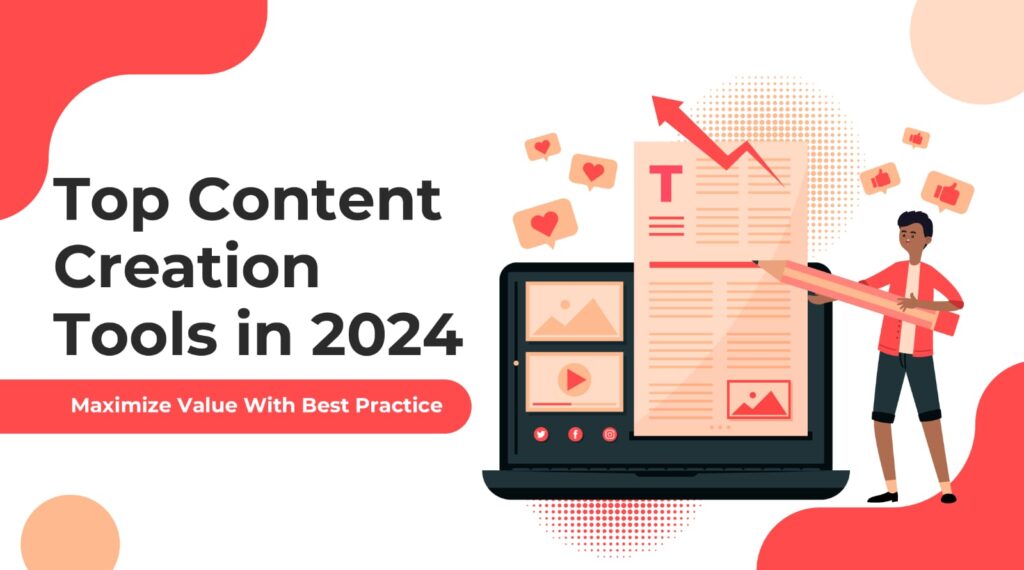Introduction
Mastering the art of content creation is akin to wielding a powerful tool for online success. As we set our sights on the digital horizon of 2024, the demand for compelling content remains unwavering. To navigate this ever-evolving terrain, content creators must harness the potential of cutting-edge content creation tools. In this comprehensive guide, we delve into the realm of Content Creation Tools: exploring the top tools that will shape the content creation landscape in 2024 and unraveling the best practices to extract maximum value from these digital assets.
In an era where attention spans are fleeting and competition for online visibility is fierce, staying ahead requires more than just flair with words. It demands a strategic approach that seamlessly integrates technology and creativity. Content creation tools have become the linchpin of this strategy, offering a spectrum of functionalities designed to streamline the content creation process, enhance quality, and ultimately, propel your content to the coveted #1 spot on Google. Join us on this journey as we dissect the very essence of content creation tools, spotlighting the best-in-class options and unveiling the strategic practices that will set your content apart in the digital sphere of 2024.
What Is Content Creation?
At its core, content creation is the art and science of crafting information in various formats to engage, inform, and resonate with a target audience. It transcends the mere act of putting words on a page or pixels on a screen; rather, it encompasses a strategic approach to deliver a message that captivates and adds value to the consumer. Content creation is the heartbeat of digital communication, spanning diverse mediums such as text, images, videos, and interactive elements.
In essence, content creation is the bridge between a brand or individual and their audience. It involves not only the meticulous choice of words but also a profound understanding of the audience’s preferences, behaviors, and the platforms they frequent. A successful content creator is not just a wordsmith; they are a strategist who navigates the evolving currents of online trends, search engine algorithms, and audience dynamics.
In the context of 2024, content creation has evolved into a multifaceted endeavor, requiring a symbiotic relationship between human creativity and technological prowess. It is no longer sufficient to rely solely on compelling narratives; the integration of cutting-edge content creation tools has become indispensable for staying competitive in the digital arena.
As we traverse the landscape of content creation tools, it’s imperative to grasp the broader concept of content creation as the orchestration of information, creativity, and technology to deliver a resonant message that leaves a lasting impact on the intended audience.
What Are The 5 C’s Of Content Creation?
The 5 C’s of content creation serve as a foundational framework to guide content creators in crafting compelling and effective content. These pillars encapsulate key elements that contribute to the success of any content strategy. Let’s explore each C:
Clarity:
Clarity is the bedrock of effective communication. Your content should convey a clear and concise message that your audience can easily understand. Avoid ambiguity and ensure that your message resonates with your target audience, aligning with their interests and needs.
Consistency:
Consistency builds trust and brand identity. Maintain a uniform tone, style, and messaging across all your content channels. Whether it’s your blog, social media, or email campaigns, a consistent brand voice fosters familiarity and loyalty among your audience.
Creativity:
In a sea of content, creativity is your differentiator. Think outside the box to capture your audience’s attention. Engaging visuals, unique storytelling, and innovative approaches set your content apart. Embrace creativity to make a lasting impression and foster a deeper connection with your audience.
Credibility:
Establishing credibility is paramount. Back your content with reliable sources, data, and expertise. Demonstrating authority in your niche builds trust and positions your content as a go-to resource for valuable information. Strive for accuracy and transparency to solidify your credibility.
Conversion:
Ultimately, content should drive desired actions. Whether it’s making a purchase, subscribing to a newsletter, or sharing your content, each piece should have a clear call-to-action (CTA). Guide your audience on the next steps, turning engagement into measurable outcomes.
These 5 C’s collectively form a compass for content creators, guiding them toward creating content that not only captivates but also strategically aligns with business objectives. As we delve into the realm of content creation tools for 2024, these principles will serve as a guiding light, ensuring that technological advancements enhance, rather than compromise, the essential elements of effective content.
What Are The 7 Steps Of Content Creation?
The content creation process is a structured journey that involves several key steps to ensure the delivery of high-quality, purposeful content. Here are the 7 steps of content creation:
1. Research and Planning:
Before you start crafting content, conduct thorough research to understand your audience, industry trends, and relevant topics. Define your goals and create a content strategy that aligns with your objectives. Planning is crucial for a well-informed and purposeful content creation process.
2. Ideation and Brainstorming:
Generate creative ideas that resonate with your audience and align with your brand. This phase involves brainstorming topics, angles, and formats for your content. Encourage collaboration among team members to diversify perspectives and identify unique angles for your content pieces.
3. Creation and Drafting:
With a solid plan and creative ideas in place, begin drafting your content outline. Whether it’s a blog post, video script, infographic, or social media copy, focus on producing high-quality, engaging content. Pay attention to the structure, tone, and visual elements that will enhance the overall impact of your message.
4. Editing and Revisions:
No piece of content is perfect on the first draft. Thoroughly edit and revise your content to ensure clarity, coherence, and grammatical accuracy. Consider seeking feedback from peers or utilizing editing tools to refine your work. A polished piece of content reflects professionalism and attention to detail.
5. Optimization for SEO:
To enhance visibility and reach a wider audience, optimize your content for search engines. Conduct keyword research and strategically integrate relevant keywords into your content. Pay attention to meta tags, headings, and other on-page SEO elements to improve your content’s search engine ranking.
6. Visual Enhancements:
Visual elements play a crucial role in capturing and maintaining audience attention. Incorporate images, infographics, videos, and other visual assets to complement your written content. Ensure that these elements are not just decorative but serve a purpose in conveying information or enhancing the overall user experience.
7. Publication and Promotion:
Once your content is refined and optimized, it’s time to publish and promote. Choose the right channels for distribution, whether it’s your blog, social media platforms, or email newsletters. Develop a promotion strategy to maximize reach, engagement, and conversions. Monitor the performance of your content and iterate based on insights.
By following these seven steps, content creators can systematically navigate the content creation process, ensuring that each piece is well-researched, creatively crafted, optimized for impact, and effectively promoted to the target audience. This methodology aligns with the evolving landscape of content creation tools, utilizing technology to enhance efficiency and amplify the impact of each step.
Importance Of Content Creation In Demand Generation?
Content creation plays a pivotal role in demand generation, serving as the catalyst for attracting, engaging, and nurturing potential customers throughout their buying journey. Here are key reasons highlighting the importance of content creation in demand generation:
1. Educating and Informing:
Content serves as a valuable resource for educating and informing your target audience. By creating content that addresses their pain points, challenges, and questions, you position your brand as an authoritative source of information. This not only builds trust but also establishes your credibility in the eyes of potential customers.
2. Building Brand Awareness:
Compelling content helps increase brand visibility and awareness. By consistently producing relevant and shareable content, you create opportunities for your brand to be discovered by a broader audience. This heightened visibility contributes to top-of-mind awareness, making your brand a natural choice when a potential customer is ready to make a purchase decision.
3. Engagement and Relationship Building:
Engaging content fosters a connection with your audience. Whether it’s blog posts, social media updates, or interactive multimedia, content provides a platform for meaningful interactions. Through comments, shares, and other forms of engagement, you can initiate and nurture relationships with your audience, transforming casual visitors into loyal customers.
4. Lead Generation:
Content acts as a powerful lead generation tool. By offering valuable content assets such as ebooks, whitepapers, webinars, or guides, you can capture contact information from potential customers interested in your offerings. This not only expands your contact database but also identifies individuals who are actively seeking solutions related to your products or services.
5. Guiding the Buyer’s Journey:
Content is strategically aligned with the stages of the buyer’s journey. From awareness to consideration and decision-making, tailored content helps guide prospects through each stage. This ensures that they receive the right information at the right time, ultimately influencing their purchasing decisions in favor of your products or services.
6. Search Engine Visibility:
Quality content enhances your search engine visibility. Search engines reward fresh, relevant, and valuable content by ranking it higher in search results. This increased visibility ensures that your brand is discoverable by individuals actively searching for products or information related to your industry, driving organic traffic to your website.
7. Differentiation and Thought Leadership:
Content creation allows you to showcase your unique perspective and industry expertise. By consistently delivering thought leadership content, you position your brand as an authority in your field. This differentiation not only sets you apart from competitors but also instills confidence in potential customers, making them more likely to choose your products or services.
8. Measurable Results:
The impact of using content creation tools in demand generation is measurable. Through analytics and key performance indicators (KPIs), you can assess the effectiveness of your content marketing efforts. Metrics such as website traffic, conversion rates, and lead generation provide insights into the performance of your content and enable data-driven optimizations.
Content creation is the backbone of a robust demand generation strategy. It creates a seamless pathway for potential customers, from initial awareness to eventual conversion, while simultaneously reinforcing your brand’s authority and value proposition. As technology evolves, leveraging content creation tools becomes integral to enhancing the efficiency and effectiveness of demand generation efforts.
What Do I Need To Start Content Creation?
Embarking on a content creation journey requires a thoughtful approach and a few essential elements. Here’s a comprehensive guide on what you need to start content creation:
1. Clear Objectives:
Begin by defining your content creation objectives. Whether it’s increasing brand awareness, driving website traffic, generating leads, or establishing thought leadership, having clear goals will guide your content strategy and measure its success.
2. Understanding Your Audience:
Know your target audience inside out. Understand their demographics, preferences, challenges, and aspirations. This knowledge forms the foundation for creating content that resonates with and addresses the needs of your audience.
3. Content Strategy:
Develop a content strategy that aligns with your objectives and audience. Outline the types of content you’ll create (blog posts, videos, infographics, etc.), the topics you’ll cover, and the frequency of your content publication. A well-defined strategy provides a roadmap for consistent and purposeful content creation.
Pro tip: Try implementing aggregated content into your content strategy, learn who are content aggregators and what they do.
4. Keyword Research:
If your content will be online, conduct keyword research to understand the terms and phrases your audience uses when searching for relevant content. This informs your content creation and helps with search engine optimization (SEO) to improve visibility.
5. Content Calendar:
Create a content calendar to organize and schedule your content. This tool helps maintain consistency in publishing and ensures that your content aligns with key events, seasons, or trends in your industry.
6. Quality Writing and Editing Skills:
Strong writing skills are foundational for content creation. Craft content that is clear, concise, and engaging. Editing skills are equally crucial; review and revise your content to ensure it meets high-quality standards.
7. Visual Content Tools:
Visual elements enhance the appeal and effectiveness of your content. Familiarize yourself with tools for creating images, infographics, and videos. Canva, Adobe Spark, and other graphic design tools can be invaluable for creating visually appealing content.
8. Basic SEO Knowledge:
Understand the basics of SEO to optimize your content for search engines. This includes incorporating relevant keywords, creating descriptive meta tags, and ensuring your content follows SEO best practices to improve its discoverability online.
9. Content Creation Tools:
Leverage content creation tools to enhance efficiency and productivity. Depending on your content type, explore tools like Grammarly for writing assistance, BuzzSumo for topic research, or Adobe Premiere Pro for video editing. Stay updated on the latest tools that can streamline your content creation process.
10. Distribution Channels:
Identify the platforms where you’ll distribute your content. This could include your website, blog, social media channels, email newsletters, and other relevant platforms where your audience is active.
11. Analytics Tools:
Implement content intelligences tools such as Google Analytics to track the performance of your content. Monitor metrics like website traffic, engagement, and conversion rates to gain insights into what works and refine your strategy accordingly.
12. Consistent Branding:
Maintain consistent branding across all your content. This includes using a consistent tone, style, and visual elements that reflect your brand identity. Consistency fosters brand recognition and builds trust with your audience.
By addressing these key components, you lay a strong foundation for successful content creation. As you gain experience, stay adaptable and open to refining your approach based on audience feedback and evolving industry trends.
12 Content Creation Best Practices To Follow
To excel in content creation and ensure your content resonates with your audience, consider these 12 best practices:
1. Understand Your Audience:
Know your target audience’s demographics, preferences, and pain points. Tailor your content to address their specific needs and interests. Understanding your audience is fundamental to creating content that engages and adds value.
2. Create Valuable and Relevant Content:
Content should provide genuine value to your audience. Address their questions, solve problems, or entertain them. Relevance is key; ensure that your content aligns with your audience’s interests and the current trends in your industry.
3. Maintain Consistency:
Consistency in tone, style, and posting schedule is crucial. This applies not only to individual pieces of content but also across various channels. Consistency builds brand recognition and trust with your audience.
4. Use a Mix of Content Formats:
Diversify your content types to cater to different preferences. Incorporate blog posts, videos, infographics, podcasts, and other formats. This variety keeps your content strategy dynamic and accommodates different learning and consumption styles.
5. Optimize for SEO:
Implement SEO best practices to enhance the discoverability of your content. Conduct keyword research, use descriptive meta tags, and ensure your content is structured for search engines. SEO optimization improves your content’s chances of ranking higher in search results.
6. Prioritize Quality Over Quantity:
Quality should always take precedence over quantity. Craft well-researched, well-written content using trusted content creation tools that aligns with your objectives. High-quality content not only engages your audience but also contributes to long-term credibility.
7. Encourage Engagement:
Foster interaction with your audience by encouraging comments, shares, and discussions. Respond to comments promptly and participate in conversations. Engagement not only strengthens your community but also signals to algorithms that your content is valuable.
8. Tell Compelling Stories:
Humans are naturally drawn to stories. Whether it’s a personal anecdote, a case study, or a narrative that illustrates a point, storytelling adds depth and emotion to your content. Stories make information memorable and relatable.
9. Mobile-Friendly Design:
Ensure that your content is optimized for mobile devices. With a growing number of users accessing content on smartphones, a mobile-friendly design is essential for a positive user experience.
10. Incorporate Visual Elements:
Visuals enhance the appeal of your content. Use high-quality images, infographics, and videos to complement your written content. Visual elements break up text, making your content more engaging and shareable.
11. Promote Your Content:
Don’t rely solely on organic reach. Actively promote your content across various channels, including social media, email newsletters, and relevant online communities. Effective promotion extends the reach of your content beyond your immediate audience.
12. Measure and Analyze Performance:
Regularly analyze the performance of your content using analytics tools. Track metrics such as website traffic, engagement rates, and conversion rates. Use these insights to refine your content strategy and focus on what works best for your audience.
By adhering to these best practices, you can elevate your content creation efforts, build a loyal audience, and achieve your strategic objectives. Flexibility and adaptability are key, so be prepared to adjust your approach based on evolving trends and audience feedback.
22 Free Content Creation Tools To Try In 2024
1. Canva:
Canva is a user-friendly graphic design tool that simplifies the creation of eye-catching visuals. Its extensive template library caters to various needs, from social media posts to presentations. With drag-and-drop functionality and customization options, Canva empowers both beginners and experienced designers to produce professional-looking graphics effortlessly, enhancing the visual appeal of your content.
Grammarly is a writing companion that goes beyond basic spell-check. It offers real-time grammar and style suggestions, ensuring your content is clear, concise, and error-free. Whether you’re drafting emails, blog posts, or social media captions, Grammarly enhances the overall quality of your writing, contributing to a more polished and professional final product.
3. BuzzSumo:
BuzzSumo is a content discovery tool that analyzes trending topics and popular content on the internet. It aids content creators in understanding what resonates with their audience by identifying influential content creators and uncovering current trends. This data-driven approach allows for a more strategic content creation process, aligning your content with what captures the attention of your target audience.
4. Pixabay:
Pixabay is a treasure trove of royalty-free images and videos. Content creators can access a vast collection of high-quality visuals without worrying about licensing issues. With its user-friendly interface and diverse range of images, Pixabay is a go-to resource for adding professional and visually appealing elements to your content.
5. Unsplash:
Unsplash is a renowned platform for high-resolution, royalty-free images. Its extensive library and user-friendly interface make it a go-to source for content creators seeking visually stunning visuals to complement their work. Unsplash’s commitment to quality and diversity ensures a wealth of options for enhancing the visual appeal of your content.
6. Google Trends:
Google Trends is a powerful tool for staying abreast of search trends. It provides insights into the popularity of search queries over time, helping content creators identify emerging topics and understand the dynamics of user interests. By leveraging Google Trends, you can tailor your content to align with current search trends and maintain relevance.
7. Hemingway Editor:
Hemingway Editor is a writing tool designed to simplify and improve your writing style. It highlights issues like complex sentences or passive voice, promoting clarity and readability. By using Hemingway Editor, content creators can ensure that their writing is accessible and engaging, catering to a wide audience.
Mailchimp is a widely used email marketing platform that offers a free plan. It simplifies the process of creating and distributing newsletters, making it an essential tool for content creators looking to engage with their audience via email. With features like customizable templates and analytics, Mailchimp facilitates effective email campaigns without a steep learning curve.
9. SurveyMonkey:
SurveyMonkey is a versatile tool for gathering audience feedback through surveys. Content creators can use it to understand audience preferences, opinions, and needs, guiding their content strategy based on real insights. By leveraging SurveyMonkey, you can make informed decisions and create content that resonates with your target audience.
Trello is a flexible project management tool that enhances collaboration and organization. Content creators can use Trello to plan editorial calendars, organize ideas, and collaborate with team members. Its visual and intuitive interface streamlines project management, ensuring that content creation remains organized and efficient.
11. Headline Analyzer by CoSchedule:
Crafting compelling headlines is crucial for capturing audience attention. Headline Analyzer by CoSchedule evaluates your headlines, suggesting improvements to enhance their emotional impact and click-through rates. This tool helps content creators create headlines that are not only attention-grabbing but also optimized for maximum engagement.
12. Google Keyword Planner:
Google Keyword Planner is an essential tool for content creators engaged in SEO. It aids in keyword research by providing insights into relevant keywords for your content. By understanding the search terms used by your audience, you can optimize your content for search engines, improving its visibility and discoverability.
13. Crello:
Crello is a graphic design tool similar to Canva, offering customizable templates for various purposes. With a user-friendly interface and a wide range of design elements, Crello empowers content creators to produce visually appealing graphics, ensuring that design does not pose a barrier to creating professional-looking content.
14. Venngage:
Venngage specializes in infographics and data visualization. Content creators can use it to transform complex information into visually engaging infographics. With its user-friendly design tools and a variety of templates, Venngage allows for the creation of compelling visuals that convey information effectively to the audience.
15. Powtoon:
Powtoon is an animated video creation platform that adds a dynamic element to content. Content creators can use Powtoon to produce engaging videos, making their content more compelling and shareable. With its intuitive interface and animation features, Powtoon brings a creative edge to video content without the need for advanced animation skills.
16. AnswerThePublic:
AnswerThePublic is a valuable tool for generating content ideas based on the questions people are asking online. By visualizing common queries, content creators can tailor their content to provide relevant answers, ensuring that their material addresses the needs and interests of their target audience effectively.
17. Portent’s Content Idea Generator:
Overcoming creative blocks is easier with Portent’s Content Idea Generator. By entering a topic, this tool generates quirky and attention-grabbing content ideas. It sparks inspiration for your next piece, helping content creators break away from conventional approaches and infuse creativity into their work.
18. Google Docs:
Google Docs is a collaborative writing tool that facilitates seamless teamwork on content creation. Its cloud-based nature ensures accessibility and real-time editing, allowing multiple team members to collaborate on documents simultaneously. Google Docs streamlines the writing and editing process, making it an essential tool for collaborative content creation.
19. Pexels Videos:
Pexels Videos offers a diverse collection of free stock videos. Content creators can integrate these high-quality videos into their content to enhance visual appeal and storytelling. With a wide range of options, Pexels Videos provides a valuable resource for incorporating dynamic visuals into various types of content.
20. Anchor:
Anchor is a free podcast hosting platform that simplifies the podcast creation process. Content creators can use Anchor for recording, editing, and distributing their podcasts to various platforms. With its user-friendly features, Anchor makes podcasting accessible to individuals and teams looking to add an auditory dimension to their content strategy.
21. Scribus:
Scribus is an open-source desktop publishing tool suitable for creating professional layouts for documents, brochures, and other materials. It provides advanced features for design, making it a free alternative for content creators seeking robust desktop publishing capabilities without the cost associated with commercial software.
22. GIMP:
GIMP (GNU Image Manipulation Program) is a powerful open-source graphic design software. It offers advanced features for image editing and manipulation, providing content creators with a free alternative to commercial software like Adobe Photoshop. With its extensive toolkit, GIMP is a versatile solution for those seeking comprehensive graphic design capabilities.
These free content creation tools cover a range of needs, from design and writing to project management and data visualization, empowering content creators to produce high-quality, engaging content without breaking the bank.
Conclusion
The array of free tools available in 2024 provides content creators with a robust arsenal to enhance their craft. From graphic design and writing assistance to project management and data visualization, these tools cater to diverse needs, empowering creators with the means to produce high-quality, engaging content. As we navigate this era of digital innovation, leveraging these tools not only streamlines the creative process but also ensures that barriers to entry are minimized, allowing creativity to flourish. With the right blend of strategy, creativity, and use of content creation tools, content creators are well-equipped to make a lasting impact in the ever-evolving digital sphere. The future of content creation is not just about the content itself but also about the tools that democratize creativity, enabling a broader spectrum of individuals to participate in the dynamic world of digital storytelling.
Maximize your content creation in 2024! Discover top tools and best practices for a stellar online presence. Elevate your strategy now.






